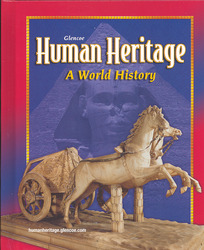Human Heritage: A World HistoryChapter 26:
Rise of Trade and TownsWeb Activity Lesson Plans“Towns of the Middle Ages”Introduction
Students have read about the characteristics of feudal societies and the reasons for the development of towns during the Middle Ages. In this exercise, students will research the daily lives of the people who lived in the towns to find out what life was like in the Middle Ages. Lesson Description
Students will use information from The Annenberg/CFB Projects Web site to learn about the lives of townspeople during the Middle Ages. Students will read about feudal life, the growth of towns, and the development of guilds. Students will read descriptions of the homes of the wealthy and of the peasants. They will also read about the daily lives of the Benedictine monks and the role of women in the towns. Students will then answer four questions and apply this information by writing a tale, similar to The Canterbury Tales, about a pilgrim on his or her way to Canterbury Cathedral. Instruction Objectives
- Students will be able to compare the lifestyles of peasants, merchants, the wealthy, and monks who lived in towns during the Middle Ages.
- Students will be able to use this knowledge to compose a tale of a pilgrim who makes a journey to Canterbury Cathedral.
Student Web Activity Answers
- The merchant class included artisans, masons, armorers, bakers, shoemakers, ropemakers, dyers, and others. As builders of cathedrals, castles, and universities, the masons were the highest paid and most respected.
- Women had the responsibility of taking care of all the household duties, but they also hunted for food and used weapons in battles. Some women were craftspeople and merchants. Additionally, women served as midwives. For recreation, women wrote, played music, danced, and painted. Some women, suspected of being witches, healed with herbs and used spells. Nuns, as ministers to the needy and to travelers, served the community.
- Peasants' homes were small, unsubstantial structures with only one or two rooms. They had thatched roofs and small windows with wooden shutters. The peasant's kitchen was the stone hearth in the center of the room. The hearth provided heat for the home and served as the cooking center. Peasants ate bread, homegrown vegetables, and dairy products, and meat from goats, cows and pigs raised on their own farms. Homes of the wealthy, on the other hand, were much fancier and more comfortable. They had tiled floors and tapestries. The larger windows were covered with a resin and tallow-soaked fabric that let in the light and kept out the drafts. The manor house kitchen was located in a separate building to minimize the risk of fire. The hearth was huge, usually large enough to roast an entire ox.
- The daily routine of the Benedictine monks included attending church eight times a day, from 2 A.M. until bedtime that night. During the day, monks read or copied religious texts or music. They carried out all of their duties in silence.
- Students' tales will vary.
 |  |





